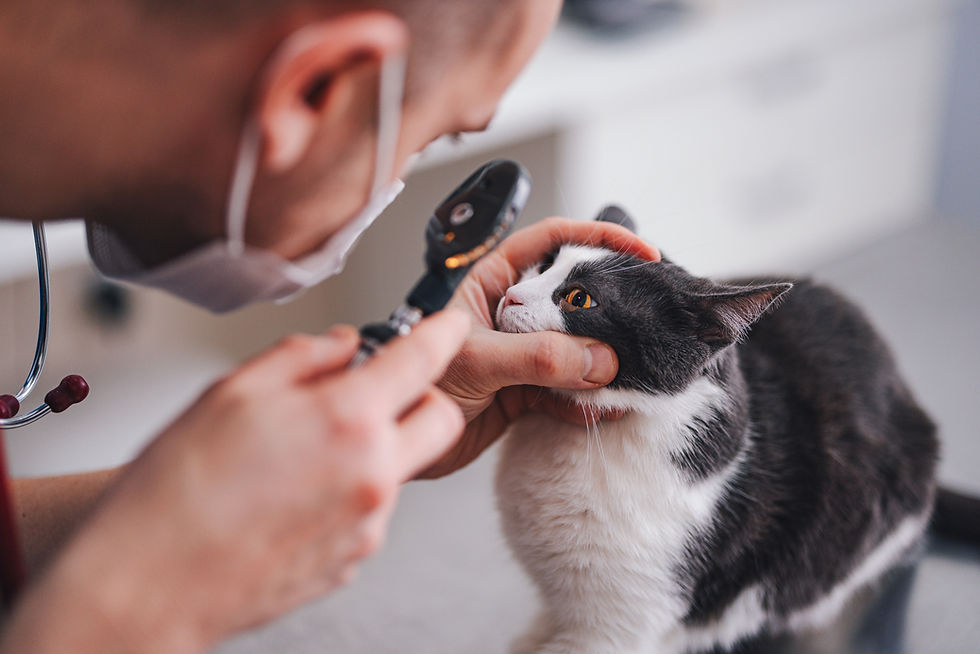Furry Fiascos: A Cat Owner's Guide to Managing Hairballs
- Carolyn O'Brien
- Mar 9, 2024
- 3 min read
Updated: May 25, 2024
Hairballs — many cat owners are familiar with this not-so-pleasant aspect of cat ownership. But what exactly are hairballs (warning - gross image ahead!) and when should you be concerned? While occasional hairballs are considered normal, understanding their causes, symptoms, and when to seek veterinary advice can ensure your feline friend remains healthy and your carpets will also thank you!
What are Hairballs?
Hairballs, known scientifically as trichobezoars, are not ball-shaped as their name suggests. They are tight, elongated clumps of hair that form in a cat's stomach. As cats groom themselves, their tongues catch loose hair, which is then swallowed. While most of this hair passes harmlessly through the digestive tract, some can remain in the stomach, gradually accumulating into a hairball.

The Science Behind Hairballs
Studies have shown that hairballs are more common in medium and long-haired cats. Frequent hairballs are also associated with overgrooming due to itchy skin or stress or can indicate gut motility issues, e.g. inflammatory bowel disease. A study published in the Journal of Feline Medicine and Surgery noted that hairball frequency can vary, but an average, healthy cat should not produce more than a couple of hairballs a year. Increased frequency of hairball vomiting should prompt a visit to the vet.
Symptoms of Hairballs
Many owners confuse coughing, which is actually a sign of airway irritation (e.g. bronchitis), with "bringing up" hairballs. It is important to remember that hairballs are vomited rather than coughed up!
Take a look at the following video to see a cat coughing due to airway disease (likely bronchitis). She was not trying to "cough up a hairball".
While the occasional hairball is no cause for alarm, it's crucial to recognise when hairballs are symptomatic of a more significant issue.
Symptoms associated with hairballs can include:
Finding them vomited up multiple times per month - especially if this is becoming more frequent
Ongoing vomiting, gagging or retching - this may indicate an obstruction
Constipation, diarrhoea or fresh blood in the faeces - due to large amounts of hair passing through the gastrointestinal tract
Weight loss or variations in appetite - hairballs can be associated with gut conditions like inflammatory bowel disease
Baldness or skin rash - a common cause of hairballs is excessive grooming due to itch or anxiety
If your cat is showing any of these signs, it's time for a veterinary consultation.
Managing and Preventing Hairballs
Cats that are over-grooming due to stress and/or itch should be managed appropriately. Likewise, if there is evidence of underlying gut disease (which may need to be diagnosed via ultrasound and possibly gut biopsies) this should be addressed with dietary changes and possibly medication.

Managing hairballs in an otherwise healthy cat is mostly about addressing the grooming routine and diet:
1. Regular Grooming: Regular brushing removes much of your cat's loose fur before it can be ingested. This is especially important for long-haired breeds. Some cats even benefit from a regular "lion clip" to reduce the volume of hair consumed.
2. Hairball Formula Cat Food: Some cat foods are formulated to improve skin and coat health and increase fibre to help the hair pass through the digestive system.
3. Lubricants: Products designed to help hairballs pass more easily through the digestive tract are available. These should only be used with a vet's recommendation, as they are often not very effective.
4. Hydration: Keeping your cat well-hydrated helps everything move through the digestive system more smoothly. Wet food and encouraging drinking by providing fresh water or a cat fountain can help.

Can hairballs be harmful?
While hairballs are generally not a cause for concern, they can occasionally cause serious intestinal blockages that may require surgical intervention. Another study in the Journal of Feline Medicine and Surgery highlighted cases where hairballs had led to significant digestive issues, underlining the importance of veterinary intervention when symptoms persist.

Conclusion
Hairballs are quite common in cats, but understanding their causes, symptoms, and treatments can help ensure you keep on top of when they can signal trouble. Regular grooming, proper diet, and vigilant observation can go a long way in preventing hairball-related issues. However, it's important to consult with one of our veterinarians if you notice any concerning symptoms. With the proper care and attention, you can help manage this furry issue and keep your cat and home (relatively) hairball-free!



